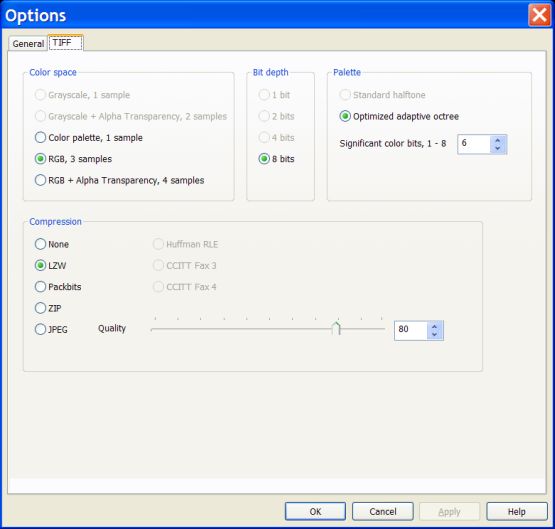"File formats: TIFF" configuration dialog
This dialog allows to specify parameters of TIFF file / stream format.

"Color space" group box
This group box allows to specify a color space used as an internal format in the TIFF image.Click a radio button in this group box to select a required color space.
"Bit depth" group box
This group box allows you to specify a bit depth of each color component.Table below shows how many colors there are in the images with the different bit detpth:
| Bit depth | Colors in the grayscale image | Colors in the color palette image |
| 1 | 2 | 2 |
| 2 | 4 | 4 |
| 4 | 16 | 16 |
| 8 | 256 | 256 |
Click a radio button in this group box to select a required bit depth.
"Palette" group box
This group box allows you to specify parameters of algorithms used to build a palette when "Color palette" radio button in the "Color space" group box is checked.if "Standard halftone" radio button is checked then palletized images are made with the standard for Windows operating system halftone palette. This method is fast but colors of that palette are not optimal for concrete images.
If "Optimal adaptive octree" radio button is checked then palletized images are made with the adaptive octree palette (Gervautz-Purgathofer octree algorithm). This method is slower but colors of that palette are adaptively selected for every concrete image. As a result quality of a final image is usually much higher.
"Significant color bits" edit and spin boxes allow setting a number of color bits used in the octree algorithm. Usually from 4 to 6 bits are enough to make a good quality palette. Increasing number of bits to 7 and 8 does not usually improve noticeably quality of palette. Best palette is made when the maximum number of significant bits, 8, But using a bigger number of bits makes calculations slower.
"Compression" check box
Controls in this group box allow you to specify a type of compression used in the TIFF image.- None - no compression is used (uncompressed data)
- LZW - lossless compression ((Lempel-Ziv-Welch algorithm)
- Packbits - lossless compression
- ZIP - lossless compression
- JPEG - lossy compression
- Huffman RLE - lossless compression
- CCITT Fax 3 - lossless compression
- CCITT Fax 4 - lossless compression
"Quality" slide, edit and spin boxes allow you to specify a level of quality for JPEG compression.
"Huffman RLE", "CCITT Fax 3" and "CCITT Fax 4" compressions can be used with monochrome images only.
"Remarks
TIFF supports a number of lossless and lossy compression algorithms.If lossless compression is used then color information is not lost in the TIFF image during compression itself, and a quality of an image converted into the TIFF format is same as it was the original uncompressed image.
There are two major exceptions from this rule. TIFF image internally may be presented in the different color spaces and with the different color bit depth. As a result some color information may be lost if during TIFF compression:
- Color space of the original image is converted into another color space with a smaller number of color components.
- Bit depth of the original image is reduced.
For example, color information is lost when original color image is saved as a gray TIFF image; or when original image with 8 bit color depth is saved as a 4 bit TIFF image.

